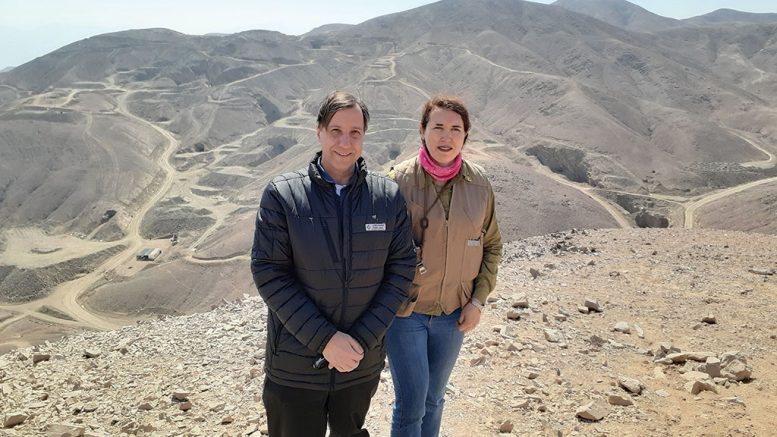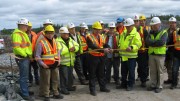MEJILLONES, CHILE — Coro Mining (TSX: COP) could soon be building Chile’s newest copper mine.
You would think someone would have already looked here.
High in the arid hills above the Chilean port of Mejillones, where metal from some of the world’s largest copper operations is shipped to Asia, a mining junior thinks it has found the country’s next mine.
Coro Mining is rapidly advancing Marimaca, an expanding copper oxide system with the potential to enter production in less than four years.
“We are already attracting the attention of large mining companies with whom we could form a joint venture,” the company’s Brazilian president and CEO Luis Tondo told reporters on a recent visit to the site.
Lower and older than the Andes, northern Chile’s coastal range is one of the world’s most prolific copper districts.
Nearby mines include Glencore’s Lomas Bayas mine, the 60-year-old Mantos Blancos operation, now owned by Mantos Copper, and Haldeman Mining’s Michilla.
But geological prejudice meant most mining companies wrote off Marimaca’s potential to host significant mineralization, despite decades of artisanal mining activity in the area.
As almost all copper discoveries made in the coastal range are hosted in volcanic rock, most geologists dismissed the area’s intrusive setting as unsuitable for hosting a large deposit, exploration manager Paola Kovacic said.
However, Coro’s vice-president of exploration Sergio Rivera noticed that the intense fracturing in the area had allowed mineralizing solutions to permeate throughout the rock.
Soon after announcing the discovery, a once-in-a-century rainfall washed away decades of dust to unveil mountainsides streaked with the telltale bright greens and turquoises.

Coro Mining CEO Luis Tondo explains a diagram during a tour of the Marimaca copper project in Chile’s Antofagasta department. Photo by Tom Azzopardi.
Toronto-listed Coro has already published a measured and indicated resource of almost 47 million tons (43 million tonnes) copper oxide, with an average 0.44% soluble copper ore grade (plus 10 million tonnes of inferred resources). With no overburden and a high-grade core, Coro says that it is enough for a mine operation. A feasibility study was published last year.
However, with a second phase of exploration drilling almost complete, the company is confident that an updated resource estimate due for publication later this year could increase the resource to over 200 million tonnes, grading 0.5% copper.
Earlier this year, the company sold its shuttered Berta mine near Copiapo to a private Chilean company for US$8.5 million, so it could concentrate on the opportunity at Marimaca.
The question now is how far the mineralization extends.
After the initial discovery, the company raised US$35 million last year, which it has used to consolidate and expand its land position, as well as finance more exploration.
Coro is carrying out scout drilling up to 2 km north and south from the discovery to see how big the system is.
To the north, the company has already drilled down through oxide and intermediate ores to hit high-grade sulphide ores underneath.
“We have never worried much about sulphides, because the quantity of oxides was sufficient to be economic … this would be a totally new game, a different project, but it shows there is potential yet to be explored,” Tondo says.
Instead, the team will begin studies on a larger operation at the project’s core, which has been expanded through new option agreements. A preliminary economic assessment, based on the enlarged resource, is due out in early 2020. Detailed engineering work would follow and take around a year to complete.
Marimaca’s location could hardly be better.
When the sea mists clear, you can see the industrial complex at Mejillones, 20 km away. Antofagasta airport is just 40 minutes’ drive, allowing early risers to visit the project on a day trip from Santiago.

Core samples on display at Coro Mining’s Marimaca copper project. Photo by Tom Azzopardi.
Power lines and aqueducts supplying other mines in the area run close by.
Its proximity to Antofagasta, the biggest city in northern Chile, means workers could travel to the mine for each shift, saving the cost of building a camp.
But the immediate area is completely uninhabited — the artisanal miners packed up four years ago, when the copper price slumped — while the extremely arid conditions mean that pink-headed turkey vultures, known as “jotas,” are almost the only fauna visible.
Back-of-the-envelope calculations suggest that an open-pit mine and leaching operation could produce 64,000 tonnes a year of high-grade cathode over a decade.
Given its location and closeness to key infrastructure, initial capital expenses could be as little as US$400 million to US$500 million.
“Capital expense is going to be much lower than other projects located in the high Andes,” Tondo says.
If permitting and construction go smoothly, the company could launch production at the site as soon as 2022.
However, given its size, Coro would likely sell the project or seek a partner to help develop it into a mine. All options are open, the executive says.
But it is in no hurry. The company still has enough money in the bank to finish work scheduled for this year, and plans to go it alone until it fully understands Marimaca’s potential.
“We don’t want to sell before we know what we have,” Tondo says confidently.
Key to Coro’s success has been the financial backing of two U.K.-based private equity firms, which together hold 70% of the company’s shares. Greenstone Resources LLP, which owns almost 56%, first got behind the company in 2015. Tembo Capital joined in last year’s capital raising and now owns 15.6%.
Their long-term investment has allowed Coro to skip the financing difficulties that hobble most mining juniors.
“The good thing with these funds is that they always have money available to keep injecting money into the project,” Tondo explains.
As well as a potential new mine, Coro says it has uncovered a geological model that could lead to discoveries along Chile’s northern coastal range.
Rivera, a former head of exploration at state mining giant Codelco, will present on fracturing in intrusive rocks at the Society of Economic Geologists’ 2019 conference in Santiago next October.





Be the first to comment on "Site visit: Coro dusts off new copper find"